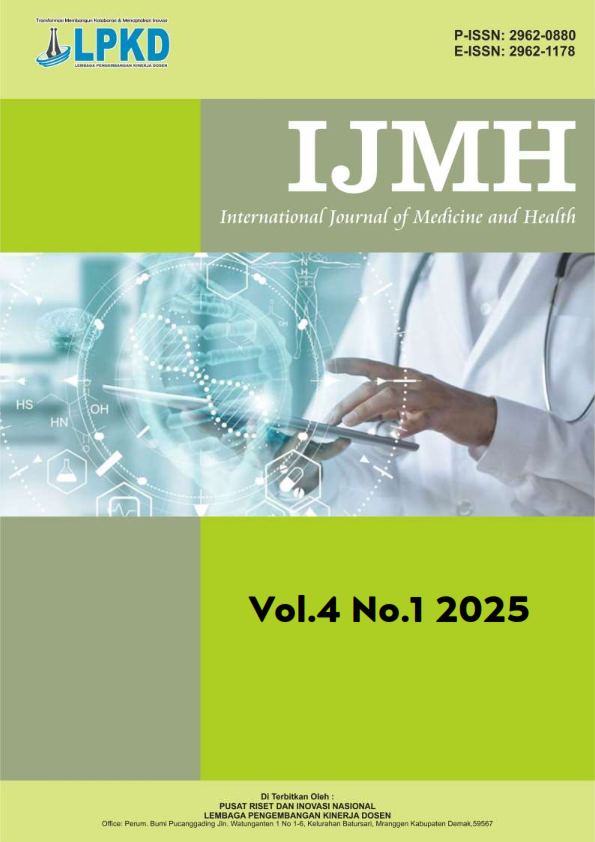Evaluation Of Liver Enzymes (ALP, ALT, AST and GGT) in Preeclamptic Pregnant Women in the Third Trimester Of Pregnancy
DOI:
https://doi.org/10.55606/ijmh.v4i1.5618Keywords:
Alanine Transaminase (ALT), Alkaline Phosphatase (ALP), Aspartate Transaminase (AST), Gamma-GlutamylTransferase (GGT), PreeclampsiaAbstract
Alkaline Phosphatase (ALP), Alanine Transaminase (ALT), Aspartate Transaminase (AST), and Gamma-Glutamyl Transferase (GGT) are liver enzymes commonly associated with liver dysfunction, and increased or decreased levels of these enzymes may be implicated in the pathophysiology of preeclampsia. This study aims to evaluate the levels of liver enzymes (ALP, ALT, AST, and GGT) in preeclamptic pregnant women in the third trimester of pregnancy. By analyzing these enzymes, the research seeks to identify potential early indicators of preeclampsia. Forty (40) consenting pregnant women were recruited from St. Philomina Catholic Hospital, Edo State, Nigeria. Blood samples were spun in a bucket centrifuge at 2500 RPM (rounds per minute) for 10 minutes, after which plasma was collected and stored frozen in plain sample bottles to be analyzed for liver enzymes (ALP, ALT, AST, and GGT) levels using the spectrophotometric method. Data obtained from the study were analyzed using Graph Pad Prism 9. Results were expressed as mean ± SEM, and a P-value of ≤ 0.05 was considered statistically significant. The present study showed a statistically significant increase in ALP, and a statistically significant decrease in liver enzymes such as ALT and AST were observed in preeclamptic women compared to normotensive pregnant women, indicating various underlying pathophysiological processes such as liver dysfunction.
References
Alese, M. O., Moodley, J., & Naicker, T. (2021). Preeclampsia and HELLP syndrome, the role of the liver. The Journal of Maternal-Fetal & Neonatal Medicine, 34(1), 117-123. https://doi.org/10.1080/14767058.2020.1798125
Apicella, C., Ruano, C. S., Méhats, C., Miralles, F., & Vaiman, D. (2019). The role of epigenetics in placental development and the etiology of preeclampsia. International Journal of Molecular Sciences, 20(11), 2837. https://doi.org/10.3390/ijms20112837
Armaly, Z., Jadaon, J. E., Jabbour, A., & Abassi, Z. A. (2018). Preeclampsia: Novel mechanisms and potential therapeutic approaches. Frontiers in Physiology, 9, 973. https://doi.org/10.3389/fphys.2018.00973
Asmanidar, A., & Emilda, E. (2024). Optimizing maternal healthcare: Holistic strategies for early detection and management of preeclampsia. Science Midwifery, 12(1), 158-167.
Bij de Weg, J. M., Landman, A. J., de Vries, J. I., Thijs, A., Harmsze, A. M., Oudijk, M. A., & de Boer, M. A. (2022). The effect of low-dose aspirin on platelet function during pregnancy compared to placebo: An explorative study. European Journal of Obstetrics & Gynecology and Reproductive Biology, 278, 67-71. https://doi.org/10.1016/j.ejogrb.2022.03.013
Chen, Y., Ou, W., Lin, D., Lin, M., Huang, X., Ni, S., ... & Liu, R. (2021). Increased uric acid, gamma-glutamyltranspeptidase, and alkaline phosphatase in early pregnancy associated with the development of gestational hypertension and preeclampsia. Frontiers in Cardiovascular Medicine, 8, 756140. https://doi.org/10.3389/fcvm.2021.756140
Duley, L. (2009, June). The global impact of pre-eclampsia and eclampsia. In Seminars in Perinatology (Vol. 33, No. 3, pp. 130-137). WB Saunders.
Georgiou-Siafis, S. K., & Tsiftsoglou, A. S. (2023). The key role of GSH in keeping the redox balance in mammalian cells: Mechanisms and significance of GSH in detoxification via formation of conjugates. Antioxidants, 12(11), 1953. https://doi.org/10.3390/antiox12111953
Greiner, K. S., Rincón, M., Derrah, K. L., & Burwick, R. M. (2023). Elevated liver enzymes and adverse outcomes among patients with preeclampsia with severe features. The Journal of Maternal-Fetal & Neonatal Medicine, 36(1), 2160627. https://doi.org/10.1080/14767058.2022.2160627
Hoq, M., Matthews, S., Karlaftis, V., Burgess, J., Cowley, J., Donath, S., ... & Monagle, P. (2019). Reference values for 30 common biochemistry analytes across 5 different analyzers in neonates and children 30 days to 18 years of age. Clinical Chemistry, 65(10), 1317-1326. https://doi.org/10.1373/clinchem.2019.315206
Kalas, M. A., Chavez, L., Leon, M., Taweesedt, P. T., & Surani, S. (2021). Abnormal liver enzymes: A review for clinicians. World Journal of Hepatology, 13(11), 1688-1705. https://doi.org/10.4254/wjh.v13.i11.1688
Mikolasevic, I., Filipec-Kanizaj, T., Jakopcic, I., Majurec, I., Brncic-Fischer, A., Sobocan, N., ... & Milic, S. (2018). Liver disease during pregnancy: A challenging clinical issue. Medical Science Monitor: International Medical Journal of Experimental and Clinical Research, 24, 4080-4086. https://doi.org/10.12659/MSM.908673
Mira, I. M. A. E. A., Sedek, A. E. M. A. E. H., Abd EL-Aziz, A. F., & Marey, A. A. (2019). Bleeding time after magnesium sulphate infusion in cases of preeclampsia. The Egyptian Journal of Hospital Medicine, 76(4), 3957-3962. https://doi.org/10.12816/ejhm.2020.4387
Sakamoto, S., Komatsu, T., Watanabe, R., Zhang, Y., Inoue, T., Kawaguchi, M., ... & Urano, Y. (2020). Multiplexed single-molecule enzyme activity analysis for counting disease-related proteins in biological samples. Science Advances, 6(11), eaay0888. https://doi.org/10.1126/sciadv.aay0888
SM, S., PP, C., MH, A., MM, R., & MM, K. (2020). A comparative study of hepatic enzymes between preeclampsia and normal pregnant women. Journal of Dhaka Medical College, 29(1). https://doi.org/10.3329/jdmc.v29i1.44860
Vilar-Gomez, E., Calzadilla-Bertot, L., Wong, V. W. S., Castellanos, M., Aller-de la Fuente, R., Metwally, M., ... & Romero-Gomez, M. (2018). Fibrosis severity as a determinant of cause-specific mortality in patients with advanced nonalcoholic fatty liver disease: A multi-national cohort study. Gastroenterology, 155(2), 443-457. https://doi.org/10.1053/j.gastro.2018.04.056
Wang, S., Ma, C., & Walsh, F. C. (2020). Alternative tribological coatings to electrodeposited hard chromium: A critical review. Transactions of the IMF, 98(4), 173-185. https://doi.org/10.1080/00202967.2020.1836622
Yadav, A., & Yadav, M. (2021). Bone health in patients of chronic myeloid leukemia on imatinib therapy. Sch J Appl Med Sci, 9(3), 390-392.
Zhang, Y., Sheng, C., Wang, D., Chen, X., Jiang, Y., Dou, Y., ... & Huang, G. (2022). High-normal liver enzyme levels in early pregnancy predispose the risk of gestational hypertension and preeclampsia: A prospective cohort study. Frontiers in Cardiovascular Medicine, 9, 963957. https://doi.org/10.3389/fcvm.2022.963957
Downloads
Published
Issue
Section
License
Copyright (c) 2025 International Journal of Medicine and Health

This work is licensed under a Creative Commons Attribution-ShareAlike 4.0 International License.






